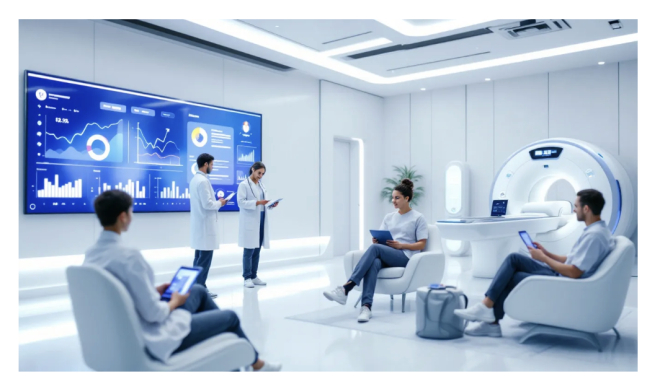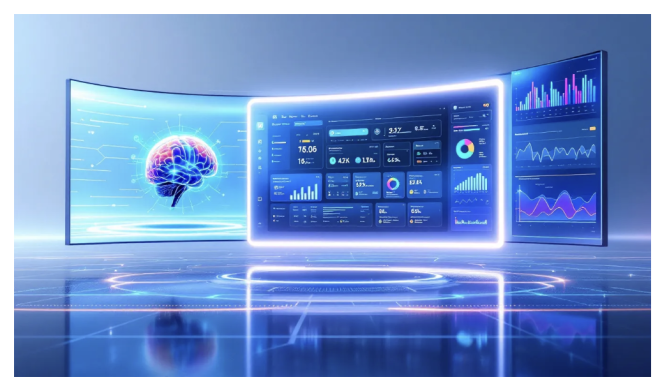- Change theme
Top Healthcare Software Solutions for 2025: Enhance Efficiency & Patient Care

In 2025, healthcare software continues to play a pivotal role in enhancing patient care and optimizing clinical and administrative workflows.
00:25 20 June 2025
In 2025, healthcare software continues to play a pivotal role in enhancing patient care and optimizing clinical and administrative workflows. From AI-powered analytics to intelligent automation, these digital solutions are transforming the way healthcare providers operate, enabling more informed decisions, faster diagnoses, and improved patient engagement. As healthcare systems become increasingly complex, the need for innovative, user-centric technologies becomes ever more critical.
To meet these demands, partnering with a healthcare software development company has become essential. Such companies offer the expertise needed to create tailored solutions that align with the specific goals and challenges of healthcare providers. Whether it’s designing custom platforms for data management or integrating cutting-edge tools for personalized care, development partners empower healthcare organizations to stay agile, compliant, and ready for the future.

The Evolving Healthcare Software Landscape
The healthcare software landscape is undergoing a significant transformation driven by technological advancements. These developments represent a digital leap forward that greatly improves the clinical and operational efficiency of healthcare delivery, as well as its efficacy. With this progression, providers and organizations in the healthcare ecosystem are able to exchange patient data more efficiently and securely, contributing to enhanced outcomes for patients.
As it stands in 2023, with a valuation of $368.15 billion, the IT market within healthcare is anticipated to experience substantial growth—estimated at nearly $834.35 billion by 2029. This surge can be attributed to an increase in health-tracking applications coupled with growing demands for robust solutions following COVID-19’s global impact—demonstrating significant potential for technology-based strategies aimed at rejuvenating responsiveness and efficiency across all aspects of healthcare.
Digital innovations extend beyond simple tasks like maintaining patient records or organizing appointments. They are instrumental in propelling both clinical operations towards greater productivity through:
- The transformative effects of telehealth services on how care is provided.
- E-prescribing software ensuring accurate medication management.
- Advanced protection over sensitive medical information.
- Simplification of complex processes within practices.
For clinicians and other health service providers today, these technologies stand out as critical aids indispensable for fostering optimal treatment experiences.
Looking ahead into what future iterations might hold regarding technological integration throughout various stages along one’s journey toward wellness indicates even more cutting-edge capabilities forthcoming from such tools—for example: Telemedicine platforms offering remote consultations reinforce connections between those requiring aid and their respective practitioners—a move set not only to enhance accessibility but also amplify both focus upon individual needs during interactional sessions alongside rendering overall assistance pathways nimbly adaptable to evolving circumstances or requirements present therein.
Leveraging Data-Driven Decisions in Healthcare
The healthcare ecosystem is undergoing a transformative shift through data-driven decision-making (DDDM), which capitalizes on the wealth of big data to target specific problems and craft strategic responses. The smooth exchange of information across health systems is now critical, improving both clinical outcomes for patients and operational efficiency for providers. Having access to accurate patient data at opportune times can significantly influence care delivery by allowing healthcare professionals to make well-informed choices that contribute to enhanced results.
Cutting-edge technologies like artificial intelligence (AI) and machine learning are spearheading this transformation in how we utilize data, sharpening predictive analytics capabilities while facilitating more individualized patient care strategies. These advanced tools process vast quantities of patient records, predicting potential future health complications so early preventative measures can be taken—a move toward better patient experiences overall. AI-powered telemedicine software offers remote diagnoses with its sophisticated algorithms making it possible for individuals—even those far from medical facilities—to benefit from prompt attention.
With predictions pointing toward an $88 billion surge in the global market value of remote monitoring solutions by 2030, sustained vigilant caregiving remains paramount within the modern landscape of healthcare services. Real-time updates on patients’ conditions delivered through these devices enable medical practitioners not only to monitor ongoing progress but also adjust treatments promptly when necessary—key factors driving up levels of engagement among patients as well as advancing their safety due to proactive management approaches.
Another pivotal technology shaping efficient healthcare practices are Laboratory Information Management Systems (LIMS). By optimizing sample tracking processes and ensuring adherence with industry standards or regulatory mandates aimed at preserving exceptional service quality throughout diagnostic procedures. LIMS integration streamlines both clinical functions and business operations alike—thereby elevating standards associated with delivering top-tier care methodologies directly impacting clientele welfare positively.
Finally, deploying DDDM methods holds significant implications within behavioral health fields where comprehending unique behaviors related alongside individually tailoring therapeutic interventions becomes immensely potentiated upon detailed analysis derived from client histories held electronically—the culmination here being not just elevated prognoses regarding physical illness recovery rates but concurrently enriching overall treatment journeys encountered via centralized emphasis placed firmly on ensuring provider actions remain resolutely oriented around satisfying every person’s singular needs during healing periods.
Enhancing Clinical and Operational Efficiency

Healthcare providers constantly strive for enhanced clinical and operational efficiency, which is a fundamental aspect of contemporary healthcare. Advancements in healthcare software have significantly bolstered both the efficiency and affordability of service provision, enabling organizations to provide high-quality care while concurrently reducing costs. For instance, remote support technologies have revolutionized access to medical services in secluded rural localities by connecting patients with health professionals, thereby elevating the revenue cycle’s quality.
Artificial intelligence (AI)-enhanced virtual health assistants are redefining how patient engagement is conducted by offering essential information and assistance on time. These innovative assistants can manage routine administrative tasks like scheduling appointments or reminding patients about their medications. This liberates healthcare professionals from such duties, allowing them to concentrate on providing direct care to patients. The resulting boost in operational efficiency complements an improved patient experience as individuals obtain necessary aid precisely when it’s needed.
The advent of e-prescribing systems has markedly increased clinical productivity too. By interfacing with national drug reference data banks, these platforms curtail prescription errors while expediting medication delivery processes—assuring that prescriptions are accurate and timely enhances both safety measures for patients as well as overall health results. Healthcare practitioners harness big data analytics to fine-tune their financial practices ensuring judicious resource deployment towards effective ends.
Optimizing operations within healthcare establishments heavily relies upon utilizing extensive datasets through big data analytics—to detect patterns guiding choices related not only to management but also allocation resources aimed at cost reduction alongside amplifying caregiving quality thus driving stronger fiscal performance down the line—for example, Laboratory Information Management Systems (LIMS) streamline laboratory procedures via precise sample monitoring whilst safeguarding regulatory adherence vital for upholding professional benchmarks across the industry.
In essence, leveraging appropriate software solutions does more than simply facilitate procedural workflows—it considerably augments team coordination amongst those involved in delivering patient treatment.By granting instantaneous oversight coupled with shared insights pertaining to real-time developments applications ensure cohesive unit activity all centered around advancing individual’s well-being culminating into superior end-results signifying heightened efficacy throughout our present-day system dedicated to attending diverse population needs regarding ailment interventions.
Custom Healthcare Software Solutions

Tailor-made healthcare software solutions are designed to align with the particular operational needs of healthcare professionals, enhancing both their effectiveness and efficiency. These customized tools aim at overcoming distinct challenges within different organizations, thereby boosting patient outcomes. For instance, an e-prescribing software crafted for seamless integration can improve workflow consistency while minimizing errors.
Healthcare providers greatly benefit from software that is specifically catered to meet their individual requirements—be it in a sprawling hospital or a cozy clinic setting. Such personalized health management solutions enhance not only the delivery of high-quality care, but also refine the entire experience of patient treatment by focusing on more targeted and responsive services.
Innovations such as remote diagnoses and telehealth platforms demonstrate how custom-tailored technology can transform access to medical care. Facilitating consultations and assessments over long distances ensures timely interventions for patients regardless of geographic constraints—especially crucial for those residing in rural or underserved regions where professional medical assistance may be scarce. Telehealth initiatives fine-tuned to address unique local demands guarantee essential health services reach these populations effectively.
Bespoke healthcare applications significantly contribute towards bolstering patient involvement and satisfaction levels through individualized treatment regimens alongside continuous monitoring options—a strategy which empowers people to become active participants in managing their own wellness journey. This empowerment leads not just to improved clinical results, but instills a deeper sense of accountability regarding one’s personal well-being maintenance routines.
Overall, highly customized health management systems are indispensable assets for any healthcare institution seeking enhancement across facets like service quality provision or heightened organizational productivity. By meeting specific provider requisites head-on, they empower physicians with reliable resources needed for dispensing optimal patient-focused medical attention efficiently.
Innovations Shaping the Future of Healthcare Software

Innovative advancements in healthcare software are poised to dramatically transform the industry’s landscape. The telehealth market is anticipated to surge, reaching a value of over $175.5 billion by 2026, emphasizing its increasing role in the provision of healthcare services. These cutting-edge developments are not only expanding access to medical care, but also bolstering patient outcomes through timely and tailored interventions.
The wearable medical device sector is on an upward trajectory as well, with forecasts suggesting a compound annual growth rate of 14.6% from 2023 to 2030. Such devices gather patient health information continuously for real-time monitoring and proactive management strategies. When integrated with healthcare software systems, these wearables provide fresh data that informs decisions made by providers and leads to enhanced patient results.
There is a strong focus within organizations on creating secure platforms characterized by openness that boost engagement among patients.
- They streamline interactions between patients and their healthcare professionals which promotes active participation in one’s own treatment.
- Access is provided not only to individualized care plans and live health updates but also comprehensive medical records.
- Patients gain empowerment regarding their journey through the world of healthcare.
Technologies like virtual reality (VR) and augmented reality (AR) are being employed within the realm of healthcare software for both training purposes among professionals in medicine as well as advancing educational tools for patients themselves. Immersive experiences from these technologies lend valuable practical knowledge helping practitioners prepare adequately while offering clear insights into intricate procedures thereby lessening apprehension amongst those receiving treatment.
To summarize this movement forward succinctly, Healthcare’s technical terrain stands at the brink of transformative progressions—integrating said novelties propels caregivers alongside institutions toward refined methods surrounding delivery practices which ultimately uplifts patient results fostering an ecosystem centered around efficiency combined with heightened attention towards individuals’ needs within healthcare contexts.
Summary
The landscape of healthcare software is undergoing swift transformations, fueled by advancements in technology and the use of data to inform decisions. These developments are overhauling how care is delivered and are key to boosting both clinical and operational efficiency. They facilitate the provision of tailored healthcare solutions that lead to enhanced patient outcomes. Looking ahead, we anticipate ongoing progress in areas like telehealth, wearable health devices, and immersive technologies to significantly reshape the future of healthcare. Healthcare providers and organizations stand at a juncture where adopting these innovative software solutions will enable them to offer superior personalized care within this ever-changing environment.
